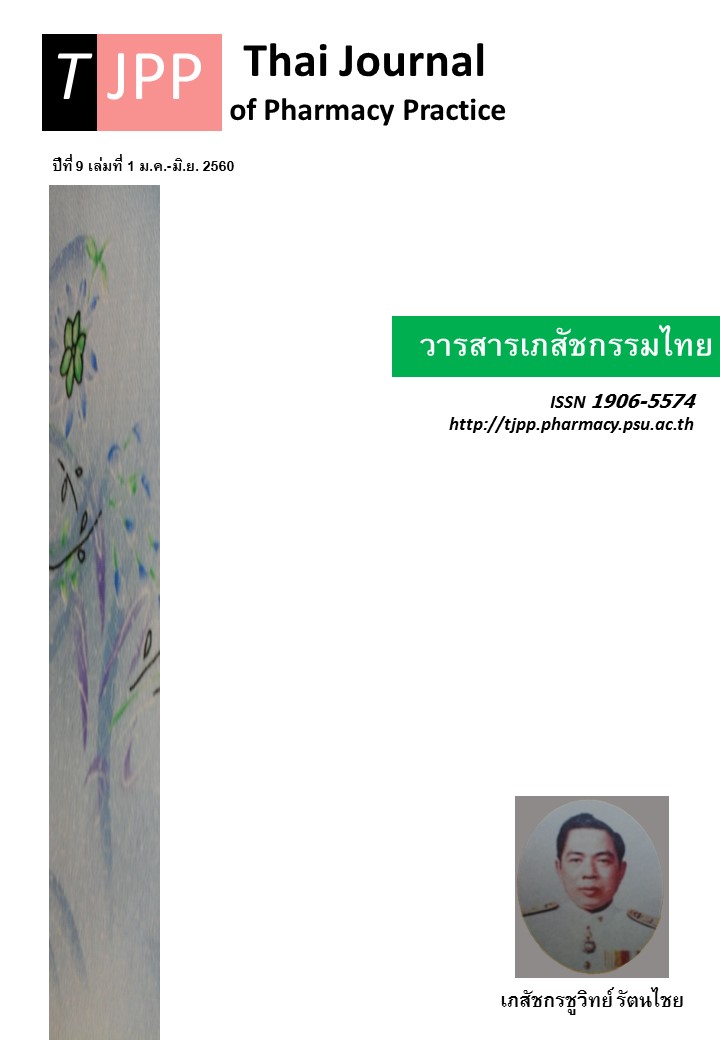การพัฒนาระบบการปรับขนาดยาสำหรับผู้ป่วยที่มีภาวะไตบกพร่อง ณ แผนกผู้ป่วยใน โรงพยาบาลปราสาท จังหวัดสุรินทร์
Main Article Content
บทคัดย่อ
วัตถุประสงค์: เพื่อพัฒนาระบบการปรับขนาดยาสำหรับกลุ่มผู้ป่วยในที่มีภาวะไตบกพร่อง และเปรียบเทียบร้อยละของการปรับขนาดยาที่เหมาะสมระหว่างก่อนและหลังการใช้ระบบ และประเมินผลกระทบด้านมูลค่ายา วิธีการ: เป็นการศึกษาเชิงปฏิบัติการ 4 ระยะ ระยะที่ 1 (ขั้นวางแผน) เป็นการประชุมคณะกรรมการเภสัชกรรมและการบำบัด (PTC) เพื่อกำหนดแนวปฏิบัติและบทบาทหน้าที่ของผู้เกี่ยวข้อง ระยะที่ 2 (ขั้นดำเนินการ) เป็นการประชุมชี้แจงแนวปฏิบัติให้แก่บุคลากรที่เกี่ยวข้องทราบ ระยะที่ 3 (ขั้นเก็บข้อมูล) เป็นการเก็บข้อมูลการปรับขนาดยาจากหอผู้ป่วย 4 แห่ง ได้แก่ หออายุรกรรมชาย หออายุร- กรรมหญิง หอศัลยกรรม และหอผู้ป่วยวิกฤต โดยเก็บก่อนและหลังการใช้ระบบคราวละ 3 เดือน ส่วนระยะที่ 4 (ขั้นสรุปผล) เป็นการสะท้อนผลการดำเนินการ และนำเสนอต่อ PTC ผลการวิจัย: องค์ประกอบสำคัญของระบบการปรับขนาดยา คือ การคำนวณค่า Creatinine Clearance (CrCL) อัตโนมัติที่ปรากฏบนหน้าจอคอมพิวเตอร์ การกำหนดรายการยาและวิธีปรับขนาดที่เป็นแนวทางเดียวกันของโรงพยาบาล และโปรแกรม HosXp® ที่ให้ข้อมูลวิธีการปรับขนาดยา ในภาพรวมพบว่า การปรับขนาดยาอย่างเหมาะสมในผู้ป่วยที่มีภาวะไตบกพร่องเมื่อคิดตามขนานยาเพิ่มขึ้นอย่างมีนัยสำคัญจากร้อยละ 65.67 เป็น 72.58 (p<0.001) และมีสัดส่วนเพิ่มขึ้นในทุกหอผู้ป่วยดังนี้ หอผู้ป่วยวิกฤตเพิ่มจากร้อยละ 49.4 เป็น 62.9 (p=0.072) หออายุรกรรมหญิงเพิ่มจากร้อยละ 69.8 เป็น 72.2 (p=0.116) หออายุรกรรมชายเพิ่มจากร้อยละ 69.8 เป็น 74.9 (p=0.384) และหอศัลยกรรมเพิ่มจากร้อยละ 59.7 เป็น 74.9 (p<0.001) หลังการใช้ระบบพบรายการยาที่ยังปรับขนาดยาไม่เหมาะสมบ่อยที่สุด 3 อันดับแรก คือ colchicine tablet 0.6 mg, ceftazidime injection 1 g และ glipizide tablet 5 mg มูลค่ายาที่สูญเสียจากการปรับขนาดยาไม่เหมาะสม ลดลงจากร้อยละ 24.5 เป็น 17.2 สรุป: ระบบที่พัฒนาขึ้นนี้มีประสิทธิภาพในการเพิ่มความเหมาะสมของการใช้ยาในผู้ป่วยไตบกพร่อง
Article Details
ผลการวิจัยและความคิดเห็นที่ปรากฏในบทความถือเป็นความคิดเห็นและอยู่ในความรับผิดชอบของผู้นิพนธ์ มิใช่ความเห็นหรือความรับผิดชอบของกองบรรณาธิการ หรือคณะเภสัชศาสตร์ มหาวิทยาลัยสงขลานครินทร์ ทั้งนี้ไม่รวมความผิดพลาดอันเกิดจากการพิมพ์ บทความที่ได้รับการเผยแพร่โดยวารสารเภสัชกรรมไทยถือเป็นสิทธิ์ของวารสารฯ
เอกสารอ้างอิง
2. Lysaght MJ. Maintenance dialysis population dynamics: current trends and long-term implica- tions. J Am Soc Nephrol 2002;13(suppl 1):S37-40.
3. Hassan Y, Al-Ramahi RJ, Aziz NA, Ghazali R. Drug use and dosing in chronic kidney disease. Ann Acad Med Singapore 2009;12:1095-103.
4. Sah SK, Wanakamanee U, Lerkiatbundit S, Regmi BM. Drug dosage adjustment of patients with impaired renal function at hospital discharge in a teaching hospital. J Nepal Health Res Conc 2014 ; 12: 54-8.
5. Decloedt E, Leisegang R, Blockman M, Cohen K. Dosage adjustment in medical patients with renal impairment at Groote Schuur Hospital. S Afr Med J 2010;100: 304-6.
6. Thanasermsuay W. The effects of pharmacist's intervention on dosage adjustment for patients with renal insufficiency at the medical wards of Ramathibodi Hospital [master thesis]. Bangkok: Mahidol University; 2549.
7. Sawadpanich C. Primary pharmaceutical care services among patients with chronic kidney disease Kantharawichai Hospital, Mahasarakham Province. Research and Development Health System Journal 2014; 7: 57-63.
8. Fijn R, Bemt VD, Chow M, De Blaey CT, De Jong-Van den Berg LT, Brouwers JR. Hospital prescribing errors: epidemiological assessment of predictors. Br J Clin Pharmacol 2002; 53: 326-31.
9. Fattinger K, Roos M, Vergeres P, Holenstein C, Kind B, Masche U, et al. Epidemiology of drug exposure and adverse drug reactions in two swiss departments of internal medicine. Br J Clin Pharmacol 2000;49:158-67.
10. Bonk ME, Krown H, Matuszewski K, Oinonen M. Potentially inappropriate medications in hospital- lized senior patients. Am J Health Syst Pharm 2006; 63:1161-5.
11. Such DA, Saez de la Fuente J, Esteva L, Alañón Pardo AM, Barrueco N, Esteban C, et al. Drug prescribing in patients with renal impairment optimized by a computer-based, semi-automated system. Int J Clin Pharm 2013; 35: 1170–7.
12. Terrell KM, Anthony J. Perkins, Hui SL, Callahan CM, Paul R. Dexter, Douglas K. Miller. Computer- ized decision support for medication dosing in renal insufficiency: a randomized, controlled trial. Ann Emerg Med 2010; 6:623-9.
13. Avorn N, Rattanadetsakul P, Rattanadetsakul J, Sommart S, Sri-u-dorn P, Surasa N. Effects of CKD Alert Pop Up development: a case study of Phanomprai Hospital, Roi-Et. The 7th Conference of Routine to Research. Bangkok. 24 – 25 July 2014.
14. Cockcroft DW, Gault MH. Prediction of creatinine clearance from serum creatinine. Nephron 1976; 16: 31–41.
15. Matzke GR, Aronoff GR, Atkinson AJ Jr, Bennett WM, Decker BS, Eckardt Kai-Uwe, et al. Drug dosing consideration in patients with acute and chronic kidney disease—
a clinical update from Kidney Disease: Improving Global Outcomes (KDIGO). Kidney Int 2011;80:1122–37.
16. Pongboroboon Y. Action Research. [online]. 2015 [Cited Oct 31, 2016]. Available from: www.mp. kus.ku.ac.th/Research_Project/Article/Yachai_AR_2.pdf
17. Lewin K. Action research and minority problems. J Soc Issues 1946; 2: 34-46.
18. Youssef A, Almubarak A, Aljohnai M, Alnuaimi M, Alshehri B, Al-ghamdi G, et al. Contraindicated medications administered to inpatients with renal insufficiency in a Saudi Arabian hospital that has a computerized clinical decision support system. J Taibah Univ Med Sci 2015;10:320-6.
19. Sellier E, Colombet I, Sabatier B, Breton G, Nies J, Zapletal E, et al. Effect of alerts for drug dosage adjustment in inpatients with renal insufficiency. J Am Med Inform Assoc 2009; 16: 203-10.
20. Garg AX, Adhikari NK, McDonald H. Effects of computerized clinical decision support systems on practitioner performance and patient outcomes : a systematic review. JAMA 2005; 293:1223-37.
21. Hou JY, Wang YJ, Kuo LN, Shen WC, Lee YY. Retrospective evaluation of the outcomes of applying the renal dosing monitoring system in a medical center. J Exp Clin Med 2011;3:176-80.
22. Office of Permanent Secretary. Service plan: rational drug use. Nonthaburi: Bureau of Health Administration; 2016.


